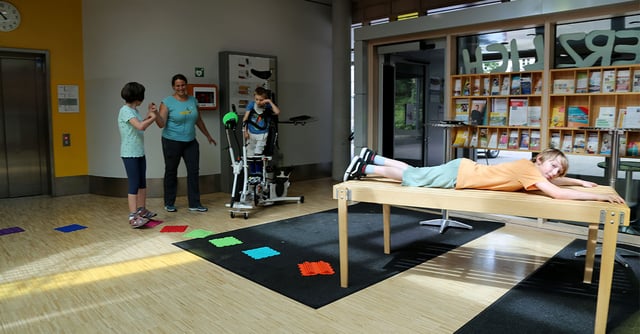
10-Aug-2023Innowalk Pro: Integrated Movement Trainer in School Life

Back to Blog Overview
Following the school motto "Right in the midst of it, not just on the sidelines", the Innowalk Pro – is located centrally in the atrium of the school. Michaela Sommer, a physiotherapist and group leader for a 1st-grade class, shares her experiences bridging therapy and education.
The Pfennigparade Foundation has been supporting people with disabilities in various life settings since the early 1950s. Their goals include inclusion and social participation. Currently, 2,500 employees are active in approximately 80 services and facilities in and around Munich. The Phoenix School is part of the foundation's educational sector. They follow the principles of conductive education, an approach that closely integrates education and therapy, developed by Professor András Petö.
Children from 1st to 9th grade attend the school, with a focus on pupils with physical disabilities. Primarily, these are children with cerebral palsy, but also with other diagnoses and severe multiple disabilities.
Michaela Sommer has been working at the Phoenix School for 11 years and, like other group leaders, collaborates with her interdisciplinary team, working with a maximum of 12 children per class. The team includes physiotherapists, occupational therapists, conductors, childcare workers, special education teachers, and also volunteers in their social year.
The Innowalk in daily use
The movement trainer Innowalk Pro was acquired through a donation from Sternstunden, a charity campaign by the Bavarian Broadcasting Corporation.
She says: "We've had the Innowalk for a long time. Our model is suitable for children between 100cm and 145cm tall, sounfortunately, not all of our pupils can use it. Fortunately, I'm working within the ideal range with the 1st and 2nd-grade children, where it fits very well!"
For information: The Innowalk Pro Large can be used by pupils up to 190cm tall.
In the Phoenix School, the Innowalk aligns perfectly with the practiced therapy concept - a holistic approach with a lot of movement in daily school life and significant emphasis on fostering independence. Equipment is used to encourage movement and provide support for the children. For example, training in standing is practiced with the use of benches or ladder-back chairs,whose backrests function as a ladder.
Additionally, there's the Innowalk Pro, deliberately placed in the central atrium.
"It's so much better than a separate therapy room. The children in the Innowalk get a lot of attention - both from other children and from adults who often pass by and praise how diligent they are! We've had very positive experiences with it, and the motivation for training is much greater."
At the Phoenix School, a lot of emphasis is placed on group activities - and here too, the Innowalk contributes to communication and interaction among the children, such as when a movement course is set up in the atrium. The child in the Innowalk is ‘right in the midst of it’, observing how other children move and engaging in conversations with them while being physically active themselves.
Individual support
The team can tailor their work with the Innowalk very individually to each child, both in terms of the number of training sessions per week and the duration of each session. When a training session takes place depends on three essential factors: Does the Innowalk Pro fit into the child's schedule? Are there sufficient staff members available - who will take care of the group when a child is placed in the Innowalk? And most importantly: How is the child's condition that day? Only when all factors align, the child trains in the Innowalk - and only then successes can be achieved!

Michaela Sommer greatly appreciates this flexibility, regarding the duration of training.
"Most children train for about 30 minutes, including getting in and out. But if a child is particularly motivated and it's feasible, they can spend more time in the Innowalk. Or we can shorten the training time if a child isn't managing."
Occasionally, children stay in the Innowalk for up to an hour, although Michaela Sommer emphasises that this is the exception rather than the norm, and the children are brought back to a sitting position to take breaks. This is a way to gradually increase the training duration.
With Felix, 9 years old, Michaela Sommer uses the Innowalk regularly - at least once a week, often more. Felix has a degenerative condition, meaning he's progressively losing his physical abilities. While he used to be able to walk, he no longer takes any steps on his own. He experiences extremely high tone in his leg muscles.
"I feel that after the training, Felix is noticeably 'softer.' The Innowalk allows him to move through his range of motion, to have weight on his legs, to remain 'smooth.' He makes walking-like movements and gets into an upright position. It's also nice that he can use his arms. I help him with gripping, but then he works with his arms on his own and has fun doing it."
Additionally, Michaela Sommer uses motivational aids such as balloons or balls to play during the training. She laughs:
Bubble blowers are also great - it makes a mess, but the kids love it!
Experience shows that after the training, the children are more alert and responsive, and they convey to their therapists that they enjoyed moving. Stories like ‘Today, we're walking to...’ also bring joy and motivation.
Successful Training for all
The hands-on time required is manageable. After adjusting the settings, it takes Michaela Sommer about 5 minutes to have the child standing in the Innowalk with everything correctly set up.
"Of course, I'm very practiced at this by now. It might take a bit longer with a child who has never used the Innowalk before, but usually not. When adjusting the seat depth, I estimate roughly how tall the child is. We have the values in the respective patient records, but I don't need them with my experience. I put the child in the Innowalk and ensure the alignment is correct. In case of doubt, I make adjustments."
Depending on the need, a table or arm-movement handles are used or simply rotated to the side.
Then, they're ready to start!
Children who are experienced with the Innowalk can even take the remote control themselves and train at their own pace, faster or slower, and take sitting breaks – of course all with an overseeing adult in sight and reach.
However, it's not just the children who benefit from the full-body movement trainer; the therapists also find its use enriching.
"It facilitates 'full-body movement.' Similar to walking movement, more weight on the feet.
As an individual therapist, I can't usually recreate this. And especially with more severely affected children, you could say, your hands get tied up. If I have a very unstable upper body and then I also have to try to move the legs, I eventually reach my limits. And in such cases, it's wonderful if I can securely stabilize the child, and the walking movements happen automatically. It's a guided movement, nicely in alignment."
At the Phoenix School, the children's developmental steps are regularly assessed, using outcome measures such as the Gross Motor Function Measure (GMFM) or the BOT-2. However, in the context of conductive education, the success of the overall concept is evaluated, making it difficult to attribute progress solely to individual measures.
But for Michaela Sommer this is important:
We integrate therapy as much into everyday life as possible. With our interdisciplinary work, different colleagues use the Innowalk - and when we notice that the children are happy, that's success enough!
The Made for Movement team would like to thank Michaela very much for her insights!

Dominik Hein studied sports science at the German Sports University in Cologne and has professional experience as sports therapist from outpatient rehabilitation centres. The last several years he has been working within medical products and technology. He is especially interested in engaging with therapist within the rehabilitation area, and support them with equipment that enhance the rehabilitation process. Dominik enjoys seeing the smile on the face of the patient when he delivers technology that motivate them in their training and how it support them to reach their goals.


